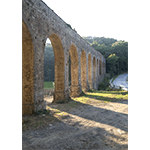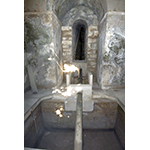Leopoldino Aqueduct
Livorno’s population increase in the course of the 18th century made a new aqueduct necessary, in substitution of the one built by Giovanni del Fantasia under the government of Ferdinando I de’ Medici. Grand Duke Peter Leopold of Lorraine entrusted the commission to Francesco Bombicci who presented a very ambitious project, which was also very costly. So it was that in 1792, the new grand duke, Ferdinando III entrusted the work to Giuseppe Salvetti from Florence, who proposed a new, less expensive solution that provided for a course through the hills, from the sources of Colognole to Livorno.
Work came to a standstill, first due to French occupation (1799) and then for the death of Salvetti himself (1801). In 1806, Queen of Etruria Maria Luisa approved the project of architect Calocchieri which aimed to conclude the work in the most economical form. The construction site was thus reopened under the direction of Ranieri Zocchi, a student of Salvetti’s. In 1809, direction passed to Pasquale Poccianti who finally brought water to Livorno on May 30, 1816 (from then until 1912, this aqueduct was the city’s principle means of water supply). Poccianti also assured maintenance with a series of works. Worthy of mention are the three large cisterns (Little Cistern of Pian di Rota, Little and Large Cisterns of Livorno) that purified the water along its course, guaranteeing an adequate distribution. In 1858, Poccianti died and was replaced by his student Angiolo della Valle, under whom the great work was completed soon after the unification of Italy.
Today it is possible to follow the fascinating route of the impressive aqueduct, which measures about eighteen kilometres, through the woods and hills of Livorno, encountering fifteen series of arches, small polygonal-shaped aedicules for the purification of the water, tunnels and cisterns.
****************************
Texts by Graziano Magrini
English translation by Victor Beard
Last update 13/feb/2008





